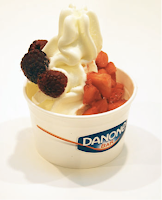"A super thick, super tasty yogurt over a layer of delicious fruit on the bottom".
Danio is a super thick, super tasty strained yogurt with a hidden layer of delicious fruit compote. Not only is it 0% fat and low fat and high in protein, each of the six fruit flavours comes in a generous 160g single pot. Danio's cup already exists in the UK and will come soon in France, in January 2014.
Indeed, in January, the British Justice condemned the american brand Chobani for using the umbrella "Greek yogurt".
If some brands have played till now on subtleties such as "Yogurt Greek Style" or "Yaourt à la grecque" as we say in French, the Greek yogurt producer Fage will thus be the only one from now allowed to use this umbrella. The question is, will Fage be able to take advantage of this...
I think this extremely changes the order of things in terms of Branding. Indeed, how to play on the wave of "Greek yogurt" hot tendency if the consumer can't figure out any longer at first glance thier stars products are actually still the "Greek yogurts" they used to have?
What about the new look of Chobani's consumers on the new cup, deprived of any Greek reference? Chobani's cup refer to the umbrella but the package doesn't play on Greek references but the fruits. In that sense, I think for Chobani it won't change that many things.
However, for Danone there is more risks: Oikos's brand new package clearly invests in Greek references!
We can wonder if Danio a good Branding in that sense. It seems Danone is taking some risks, even if the product's description clearly shows the characteristics of what we know as a Greek Yogurt. Though Danio is branded as being produced by Danone's yogurt experts in Poland.
Danio is branded as an innovation on the new segment of "Hyperproteinated yogurts".
But considering the "Commoditization" we can talk about between Greek yogurt and Hyperproteinated yogurt, one could think this "new innovative segment" is just a Marketing's strike to counter the new law in favor of Fage.
To comfort this idea, a special facebook page & twitter account have been developed for this special product and prove to be very active & successful.
 |
| A follower's picture on Twitter |
Is the new law about Greek umbrella going to increase Fage's market share?
One thing is sure, Chobani & Danone are at the same level now and with Danio that will be sold 1euro a cup, the price war is getting even harsher...
Cécile Vendeville





